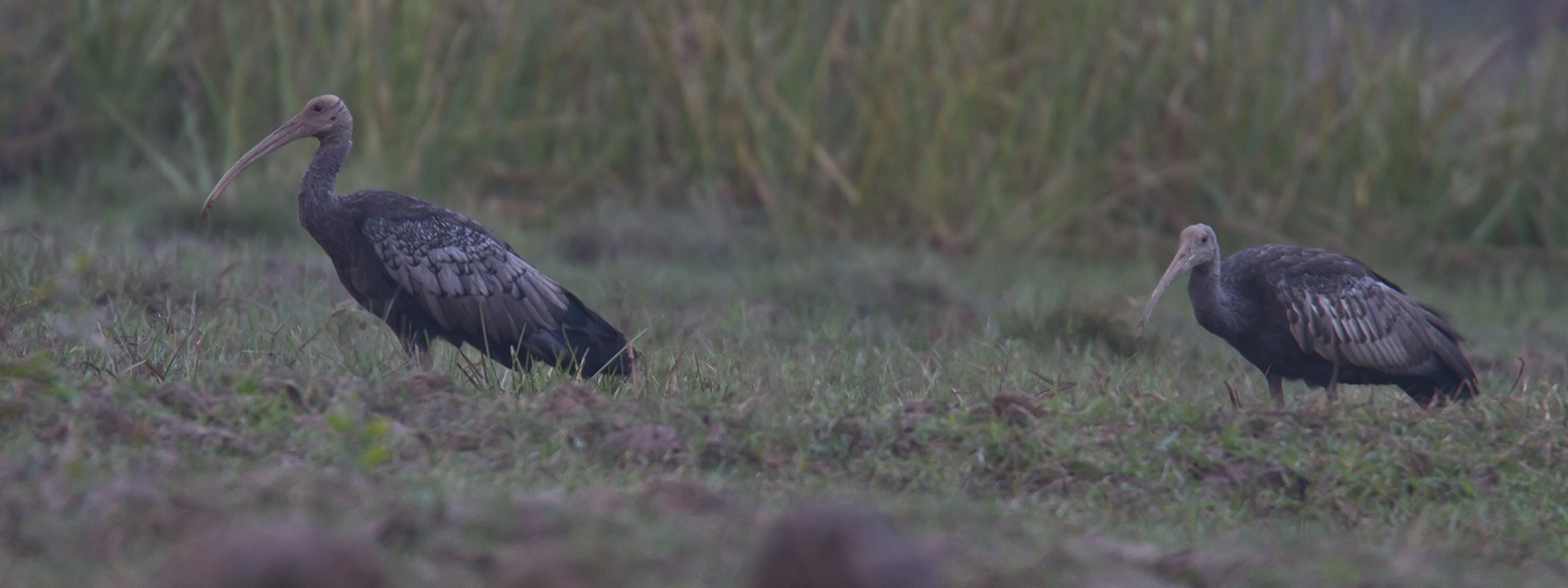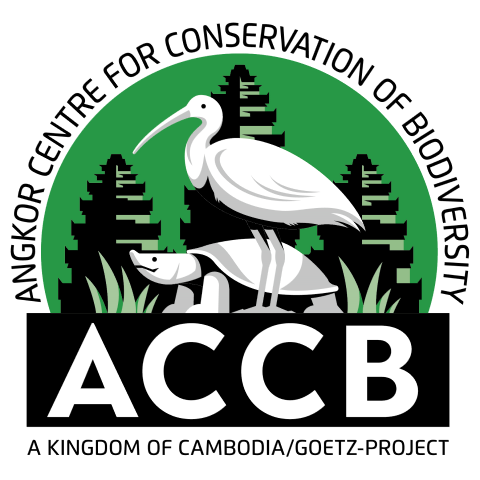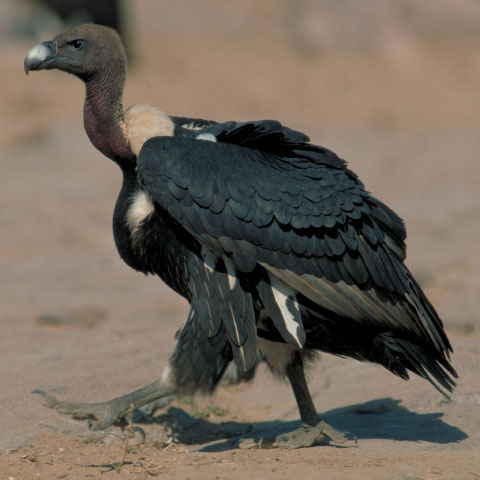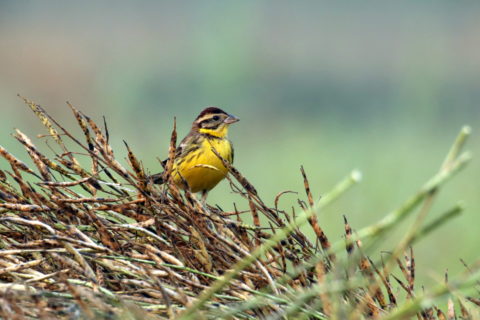Conservation Actions
Conservation Actions UnderwayThe species was listed as Critically Endangered in Cambodia by the Ministry of Agriculture, Forestry and Fisheries in 2007 and hunting of the species was prohibited in Cambodia in 1994 (Loveridge and Ty 2015). A 10-year Giant Ibis National Action Plan was published in 2015 (Loveridge and Ty 2015). The plan aims are that by 2025 the Giant Ibis population will be stable or increasing and the species will inhabit a network of well-protected sites. These objectives will be achieved via three channels: 1) protecting key habitat where the species is present; 2) implementing management interventions to increase survival and breeding success; 3) conducting research to inform conservation actions. The delivery of these activities will be monitored by the Ibis Working Group which is currently being established (Loveridge and Ty 2015).
Actions are ongoing to protect the species's breeding and foraging habitats. The Forestry Administration and Ministry of Environment in Cambodia are working to strengthen protected area management at key sites for the species, with support from organisations including Angkor Centre for Conservation of Biodiversity, BirdLife International, Conservation International, Wildlife Conservation Society and the World Wildlife Fund (Loveridge and Ty 2015). The entirety of the Western Siem Pang IBA has been designated as Wildlife Sanctuary, with the Prey Siem Pang Lech Wildlife Sanctuary forming the southwestern area of 65,389 ha., and the northern half (66,932 ha) upgraded from Protected Forest to Wildlife Sanctuary in the same decree on 9th May 2016 (BirdLife International Preventing Extinctions Programme, unpublished report). It occurs at least seasonally in Xe Pian National Biodiversity Conservation Area (NBCA) and Dong Khanthung proposed NBCA, Laos, and Lomphat Wildlife Sanctuary, Preah Vihear Protected Forest, Kulen Prumptep Wildlife Sanctuary and Mondulkiri Protected Forest in Cambodia. Ecotourism projects in the Northern Plains landscape (Tmatboey, O Koki and Prey Veng) and certified wildlife-friendly "Ibis Rice", sold for a premium, also benefits the species through restricting small-scale habitat conversion. Restoration of foraging habitats around waterholes is being trialled.
Management to improve breeding success currently involves targeted actions to protect nests and engaging with local communities. Ongoing community nest protection activities are taking place in the Northern Plains (Clements et al. 2013), where local community members are paid to protect Giant Ibis and other waterbird nests. This not only removes a primary threat to the population, but instils local ownership and pride in the charismatic large waterbirds in this landscape. However there is some concern that additional people visiting the nest guardian may lead to additional disturbance. Giant Ibis is depicted on public awareness materials in Lao PDR and Cambodia as part of an on-going campaign to reduce hunting of large waterbirds. A predator-exclusion experiment in 2005-2006 found that nests with predator-exclusion devices (a smooth, hard plastic belt fixed around the base of the nest tree) were more likely to survive than those without (Keo 2008). Such devices may alert hunters to the presence of nest sites and must be combined with community engagement work to deter hunting (Loveridge and Ty 2015). Work to improve habitat by deepening trapaengs has taken place at 19 of the water holes so far to early 2018 through the implementation of Species Guardian action and funding via the Darwin Initiative and Fondation Segre.
Monitoring is undertaken to assess the effectiveness of actions designed to benefit the species. Reproductive success is assessed through direct monitoring of breeding pairs whilst important populations are surveyed during the dry season (Loveridge and Ty 2015). Changes in forest cover are monitored using remote-sensing techniques (Loveridge and Ty 2015). Following the discovery of an individual in the Kampong Som Valley in Koh Kong Province, Cambodia, Wildlife Alliance plan to survey the area for breeding Giant Ibises (Hance 2012).
'Giant Ibis Transport' took on the role of Species Champion in 2013, agreeing to provide $51,000 of funding over a three year period (Sartori 2013). It was nominated as the national bird of Cambodia in 2005 (Loveridge and Ty 2015).
Conservation Actions Proposed
Key actions as identified by the Giant Ibis National Action Plan are: to establish protected areas around key habitat for the species; at the site level, implement conservation actions designed to benefit the species and list the species as a conservation priority at these sites; improve law enforcement; encourage sustainable management of forest resources; provide support to local communities to reduce overexploitation of key habitat for the species (Loveridge and Ty 2015).
Improved commitment to conserve protected areas in Cambodia is required by all stakeholders to stabilise the Giant Ibis population. Advocacy with the Cambodian government to raise the profile of the ecological needs of Cambodia’s national bird will help improve protection of the large undisturbed areas of deciduous dipterocarp forest that this species requires. Establish further protected areas encompassing large tracts of habitat found to support populations of the species, including strict protection of suitable permanent wetlands, especially in the dry season. At key sites, designate some suitable pools as for use only by wildlife. Ensure some pools remain wet during the dry season (e.g. by preventing people from draining them for fishing, and also potentially managing pools to increase their depth) (Keo 2008). Restore foraging habitat. Protect and install anti-predator belts on all nest-trees and work with community groups to deter hunting behaviour (belts around trees may attract hunters to the species's nesting trees) (Loveridge and Ty 2015). Consolidate and promote further public awareness initiatives to reduce hunting of large waterbirds and wetland disturbance.
Conduct further surveys to locate and quantify remaining populations in Laos and Cambodia (particularly undersurveyed areas such as Lomphat Wildlife Sanctuary [planned for 2018], Mondulkiri Protected Forest and Mekong Bird Nest Protection site near Kratie [Loveridge and Ty 2015]). Investigate its breeding requirements (including breeding season foraging ecology), demography and seasonal movements. Assess longer-term risk from climate change (T. Evans in litt. 2012). Monitor the abundance of frogs, eels and mole-crickets in the dry season (Keo 2008), and the impact that local harvesting of frogs may have on prey abundance (H. Wright in litt. 2012).
Location Information
The species is mostly confined to northern and eastern Cambodia, where it is probably still fairly widespread but extremely rare; with a few birds from the same population observed in extreme southern Lao PDR (BirdLife International 2001). It has also been recorded from Yok Don National Park, Viet Nam (Anon 2003), with the most recent sighting of a single bird in 2011 (Loveridge and Ty 2015). Its historical range spanned southern Viet Nam and south-eastern and peninsular Thailand, where it is now extinct.Available data suggest that it has a patchy distribution across Cambodia (T. Clements et al. in litt. 2007). Some areas of high density exist in the Northern Plains, including Preah Vihear Protected Forest and Kulen Promtep Wildlife Sanctuary (with 30-40 nests monitored annually [T. Evans in litt. 2012] and 24 pairs monitored in 2014 [WCS 2014 in Loveridge and Ty 2015]) and Prey Siem Pang Khang Lech Wildlife Sanctuary (formerly Western Siem Pang IBA) (where a slight decline has been detected from around 40 pairs [H. Wright in litt. 2012] to 49±10 individuals in 2014 [Ty et al. 2016]). Other areas appear to have relatively low density populations, which may be clustered in some cases: Lomphat Wildlife Sanctuary (approximately 10-15 pairs [Sum and Bou 2012]), Seima Protection Forest (estimated at five pairs [T. Evans, H. Rainey, R. Vann and H. Wright in litt. 2012 in Loveridge and Ty 2015]) (WCS/FA 2006, Bird et al. 2007), Mondulkiri Protected Forest (anecdotal reports suggest a population of approximately 50 individuals [Gray personal communication in Loveridge and Ty 2015]) (T. Gray in litt. per T. Evans) and Phnom Prich Wildlife Sanctuary (estimated at five pairs [T. Evans, H. Rainey, R. Vann and H. Wright in litt. 2012 in Loveridge and Ty 2015]) (Claassen and Ou 2007, T. Clements et al. in litt. 2007, T. Clements et al. in prep.).
Additional recent records have come from Veunsai proposed Protected Forest in Ratanakiri Province (estimated at five pairs [T. Evans, H. Rainey, R. Vann and H. Wright in litt. 2012 in Loveridge and Ty 2015]) and the first observation south of Tonle Sap Lake since the 1920s was made by camera trap in 2011 (L. Perlman per T. Evans in litt., Hance 2012). Further surveys may confirm other localities in suitable areas such as O Ya Dao Protected Forest (although the majority of suitable habitat in this area has now been converted to economic land concessions [Loveridge and Ty 2015]) and the unprotected areas west of Phnom Prich Wildlife Sanctuary (T. Evans in litt. 2012). Owing to large scale habitat loss the species's range is likely to have decreased between 2008 and 2015 (Loveridge and Ty 2015).
Geographic Range
Extant
Cambodia, Lao People's Democratic Republic, Viet Nam
Population Information
An assessment of the global population was made in 2014 based on newly collected data and expert opinion (including estimates of 48 and 35 mature individuals at the highest density sites) (Loveridge and Ty 2015). The population was estimated at a minimum of 194 mature individuals which is equivalent to approximately 290 individuals.Threats
This species has declined as a result of hunting and egg collecting, wetland drainage for agriculture and deforestation. Habitat conversion by large-scale economic land concessions was recently identified as the greatest threat to the species (Loveridge and Ty 2015). Clearance of very large areas of lowland dry forest, including parts of the Northern Plains (Preah Vihear Protected Forest, Kulen Promtep Wildlife Sanctuary) and other areas (Lomphat Wildlife Sanctuary, Western Siem Pang IBA, Snoul Wildlife Sanctuary, O Ya Dao Protected Forest [Loveridge and Ty 2015]) where the species occurs has already taken place for conversion to agro-industrial uses including rubber, cassava, wood pulp and teak plantations. Small-scale agricultural expansion for subsistence agriculture is also considered a threat (Loveridge and Ty 2015). Generally the human population is increasing within the range of this species mostly through immigration from other provinces in Cambodia, resulting in more infrastructure and development projects that contribute to forest loss. Subsequent expansion of agricultural land and increasing hunting pressure and disturbance at feeding sites is causing the loss of breeding habitat for the species (An Dara 2008, Clements et al. in prep.). Construction of new roads through Siem Pang and Seima Protected Forest threaten the species's habitat and potentially expose it to increased disturbance (Loveridge and Ty 2015). Construction of hydroelectric dams in the upper Mekong tributaries (Lower Se San 2 Dam and Lower Sre Pok 2 Dam) could lead to the loss of suitable habitat along the Srepok and Sesan rivers (Loveridge and Ty 2015).It relies on seasonal pools (trapaengs), which in the past were perhaps maintained by the now much depleted megafauna. The species appears to be very sensitive to human disturbance (An Dara 2008, Wright et al. 2012, Ty 2013), particularly during the dry season when both birds and humans are concentrated around available waterholes rendering much apparently suitable habitat unusable. The frequency of burning in deciduous dipterocarp forest has recently increased, potentially having a negative impact on food resources for the species (Loveridge and Ty 2015). Suitable nesting trees may be removed by commercial timber extraction operations or for subsistence housing construction, resulting in the species having to use suboptimal nesting trees (Loveridge and Ty 2015). Nest predation by Common Palm Civet Paradoxurus hermaphroditus and/or Yellow-throated Marten Martes flavigula on two occasions in 2004 suggest that loss of nestlings to mammalian carnivores might be a significant constraint on breeding success (Keo 2008), a theory supported by a study which found that the number of young fledged per nest was 50% higher for protected nests (Keo et al. 2009). A prolonged drought in the 2009-2010 dry season appeared to dramatically lower the breeding success of Giant Ibis, by approximately 50%; climate change may therefore pose an additional long-term threat to the persistence of this species (H. Rainey in litt. 2012).
Partners
IUCN Red List Account Link
Please click here to see the species' IUCN Red List Account page.Photo Credits
Eleanor Briggs - WCS (category and featured image)








